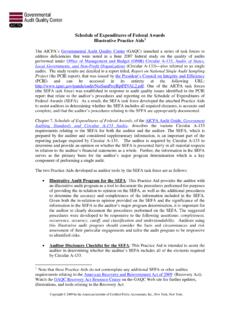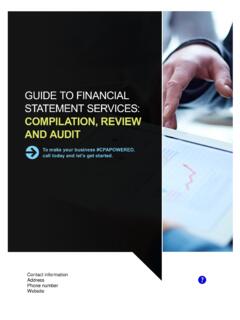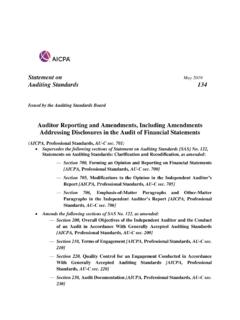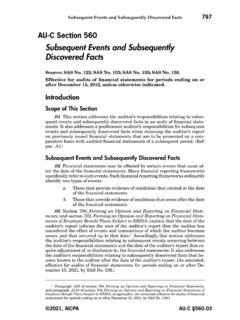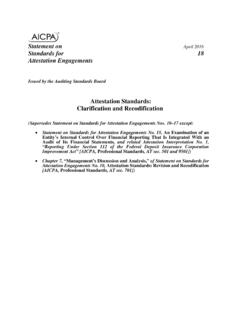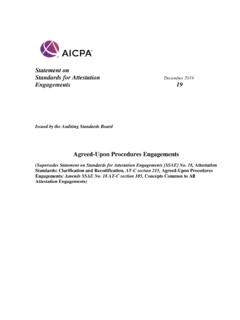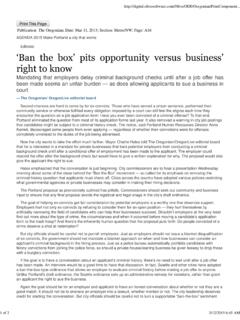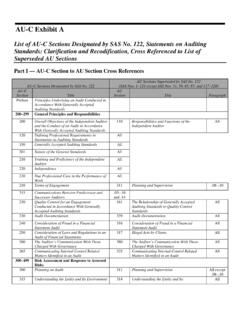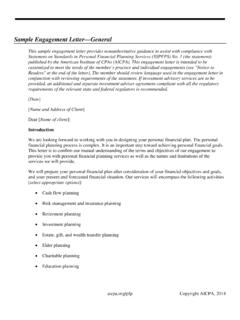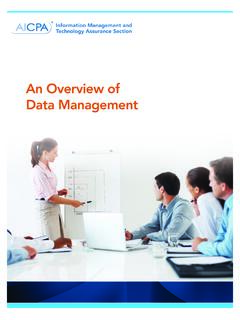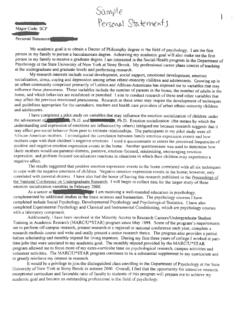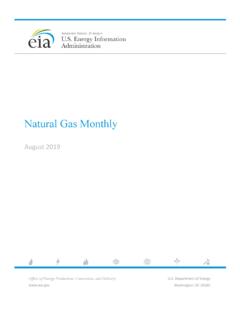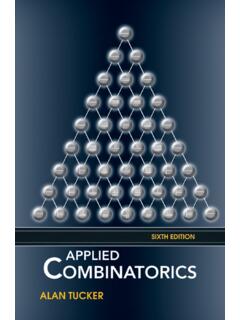Transcription of Single Audit Fundamental Series Part 4: Overview of ...
1 Overview of Sampling and Single Audit Reporting RequirementsAugust 27, 2020 Governmental Audit Quality CenterEarning CPED isable allpop-up blockersDo not enlarge any windows as they can block you from seeing CPE markersAny answer counts towards CPE creditEarn credit by responding to 75% of pop-upsClick the CPE buttonat the end of this webcast to claim your CPE certificateIf you viewed this webcast as a group, fill out the Group Viewing Form located in the same windowA post event e-mail with CPE information will be sent to you2 Per NASBA, you cannotearn CPE credit by watching the archive of this Helpful HintsAdjust your volume Be sure your computer s sound is turned on. Click this button. Slide the control up or down to fit your your questions Feel free to submit content related questions to the speaker by clicking this button. Someone is available to assist with your technology and CPE related questions, as well.
2 Download your materials Access today s slides and learning materials by clicking this download button at any time during this presentation. If you need help accessing these materials, send a message through the Q&A Closed Captioning Enable Closed Captioning by clicking the CC box found at the bottom of your screen. If you are watching a rebroadcast, the CC button is located within the Media s speakersRachel Flanders,CPA,CliftonLarsonAllenErica Forhan,CPA, Moss Adams4 Single Audit Fundamentals A Four Part SeriesPart 1, What is a Single Audit ? A Basic Background and OverviewPart 2, Major Program DeterminationPart 3, Understanding and Testing Compliance Requirements and Internal Control over CompliancePart 4, Overview of Sampling and Single Audit Reporting5 What we will coverSampling concepts in a Single auditEvaluating results of testing Single Audit reporting requirements under Uniform Administrative Requirements, Cost Principles, and Audit Requirements for Federal Awards at 2 CFR 200 (UG or Uniform Guidance) Single Audit quality and best practicesResources to facilitate a Single audit6 Terminology & abbreviations7 CAPC orrective Action PlanIRInherent riskCFDAC atalog of Federal Domestic Assistance (now known as Assistance listings)
3 OMBO ffice of Management and BudgetDCFData Collection FormPTEPass-Through EntityFACF ederal Audit ClearinghouseQCRQ uality Control ReviewGAASG enerally Accepted Auditing StandardsSEFAS chedule of Expenditures of Federal AwardsGAGAS or Yellow BookGenerally Accepted Government Auditing StandardsSFQCS chedule of Findings and Questioned CostsGAQCG overnmental Audit Quality CenterSSPAFS ummary Schedule of Prior Audit FindingsGAS-SA GuideAICPA Audit Guide, Government Auditing Standardsand Single AuditsUGUniform GuidanceSampling concepts in a Single auditDiscussion What is the best advice you would give beginners about sampling in a Single Audit ?9 Sampling concepts statistical vs. nonstatistical10 Auditor may choose between a statistical and a nonstatistical approach to Audit samplingNonstatistical sampling used most often in a Single auditTests of Controls Provide evidence about the effectiveness of the design, implementation, or operation of controls and policies in preventing or detecting material noncompliance.
4 Concern: Ratesof deviations from a prescribed control. Tests of Compliance Provide evidence about an auditee s ability to adhere to the direct and material compliance requirements of its major programs. Concern: Ratesand potential magnitudeof concepts -attribute vs. monetary sampling11 Attribute sampling recommended for both tests of controls and tests of compliance Tests of Controls: Common to apply attribute sampling for tests of controls (yes/no) Tests of Compliance: Some populations involve monetary amounts, but focus is on evidence of compliance (yes/no)Attribute sampling allows the auditor to: Project a sampling error to the sample population Establish best estimate of questioned costsSet up your sample for success: determine Audit objectives12 Proper definition and documentation of the Audit objective precedes sampling design and execution. Separate objectives for tests of control and complianceExamples: A necessary control was performed effectively.
5 An expenditure charged to a grant is allowable under the cost principlesDefine population, consider completenessUnderstand the characteristics of the population Remove individually important items Identify the sampling unit (eligibility files, expenditures, financial reports, cost transfers) Each transaction or instance of the control has an equal opportunity of being selected May be more than one type of transaction/control Allowable costs payroll vs. other than payroll13 Define population, consider completenessProperly identify the universe of transactions Remember: auditor s opinion is on the compliance requirements that could have a direct and material effect on EACH major program Controls: Possible to test across major programs for controls Compliance: Treat each major program as a separate population for compliance testing14 Determine sample size controls -suggestedminimumsample sizes15 Significance of Control and Inherent Risk (IR) of Compliance Requirement Minimum Sample Size0 deviations expectedVery Significant and Higher IR60 Very Significant and Limited IROrModerately Significant and Higher IR40 Moderately Significant and Limited IR25 Suggested minimum sample sizes for populations >250 Internal control over complianceTests of Controls Sampling Table Small Frequency/Population ControlsNo Deviations ExpectedControl FrequencySample SizeQuarterly(4)2 Monthly (12)2 4 Semimonthly(24)3 8 Weekly (52)
6 5 916 Determine sample size compliance suggested minimum sample sizes17 Suggested minimum sample sizes for populations > 250 Degree of Assurance NeededHighModerateLow604025 Dual purpose sample considerations18 Common practice to utilize a Single sample to achieve multiple Audit objectives Internal control over compliance testing Compliance testing Financial statement balance testing Exercise caution: Different characteristics are for different objectives If there are errors in internal control, the planned compliance sample may not be adequateEvaluating sample results19 ALL deviations/exceptions should be evaluated to: Understand the likely cause Determine if it should be reportedJustify containment of deviation/exception Additional Audit work necessary to contain Documentation should explain why the deviation/exception is not expected to be representative of other deviations/exceptions in the broader populationEvaluating results of testingKey definitions21 Control deficiency-exists when the designor operationof a control over compliance does not allow management or employees, in the normal course of performing their assigned functions, to prevent, or detect and correct, noncompliance on a timely basis.
7 A deficiency in designexists when (a) a control necessary to meet the control objective is missing, or (b) an existing control is not properly designed so that, even if the control operates as designed, the control objective would not be met. A deficiency in operationexists when a properly designed control does not operate as designed or the person performing the control does not possess the necessary authority or competence to perform the control effectivelyKey definitions22 Significant deficiency in internal control over compliance-is a deficiency, or a combination of deficiencies, in internal control over compliance with a type of compliance requirement of a federal program that is less severe than a material weakness in internal control over compliance, yet important enough to merit attention by those charged with weakness in internal control over compliance -is a deficiency, or combination of deficiencies, in internal control over compliance such that there is a reasonable possibility that material noncompliance with a type of compliance requirement of a federal program will not be prevented.
8 Or detected and corrected, on a timely definitions23 Audit Finding -deficiencies which the auditor is required by Audit Findings to report in the SFQC Questioned Costs -costs that are questioned by the auditor because of an Audit finding: which resulted from a violation or possible violation of a statute, regulation, or the terms and conditions of a federal award, including funds used to match federal funds where the costs, at the time of the Audit , are not supported by adequate documentation where the costs incurred appear unreasonable and do not reflect the actions a prudent person would take in the results of tests of controls24 Tests of internal control may identify deficiencies, considered Audit findingsNeed to understand deviation and consequencesAuditor should evaluate the severity of each deficiency to determine whether, individually or in combination, is a.
9 Material weakness Significant deficiencyDetermination of whether a control deficiency is a significant deficiency or material weakness for the purpose of reporting an Audit finding is in relation to a type of compliance requirement for a major program Evaluating results of tests of controls25 Severity of a deficiency depends on: the magnitude of potential noncompliance resulting from the deficiency or deficiencies; and whether there is a reasonable possibility that the entity s controls will fail to prevent, or detect and correct, noncompliance with a type of compliance requirementThe significance of a deficiency in internal control over compliance depends on the potential for noncompliance, not on whether noncompliance actually has absence of identified noncompliance does not provide evidence that identified deficiencies in internal control over compliance are not significant deficiencies or material factors 26 Risk factors affect whether there is a reasonable possibility that a deficiency, or combination of deficiencies, will result in noncompliance with a type of compliance requirement of a federal program.
10 The factors include, but are not limited to: the nature of the type of compliance requirement involved. susceptibility of the program and related types of compliance requirements to fraud. subjectivity and complexity involved in meeting the compliance requirement and the extent of judgment required in determining noncompliance. interaction or relationship of the control with other controls. interaction among the deficiencies. possible future consequences of the of potential noncompliance27 Factors affecting the magnitude of potential noncompliance that could result from a deficiency or deficiencies in controls include, but are not limited to: program amounts or total of transactions exposed to the deficiency in relation to the type of compliance requirement; volume of activity related to the compliance requirement exposed to the deficiency in the current period or expected in future periods; or adverse publicity or other qualitative of material weaknesses28 Identification of fraud in the major program of any magnitude on the part of senior program management.
